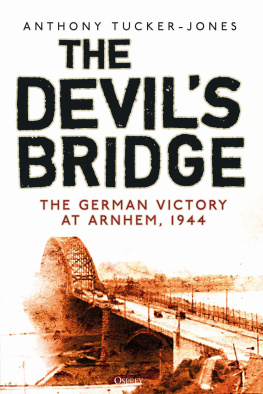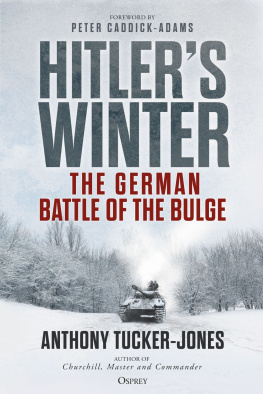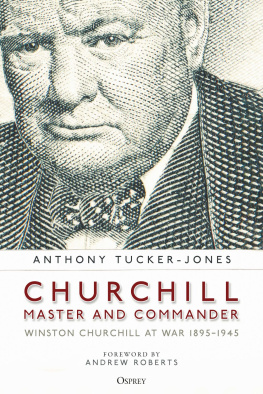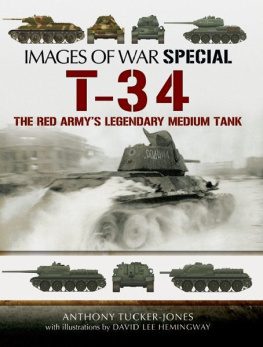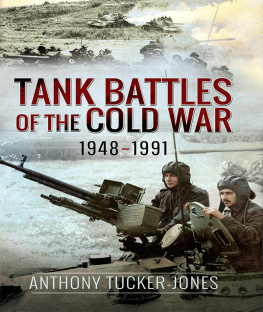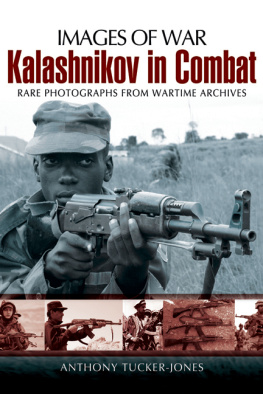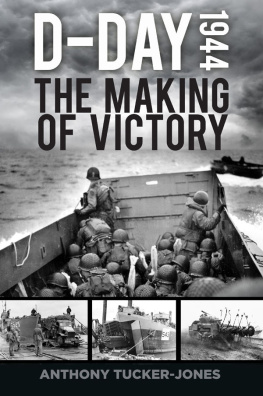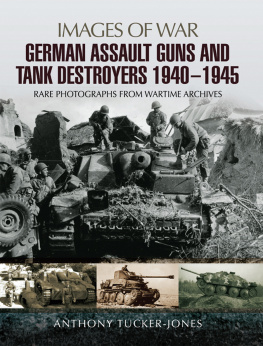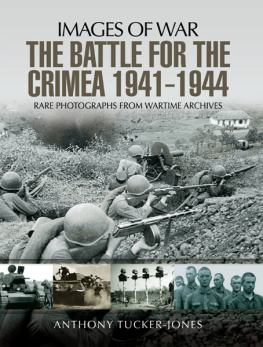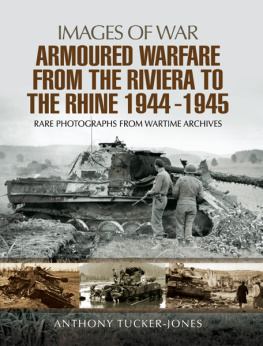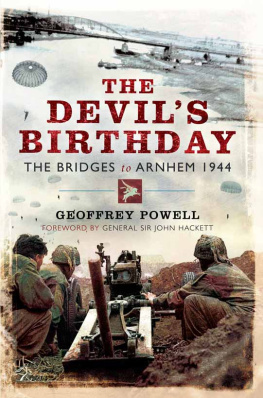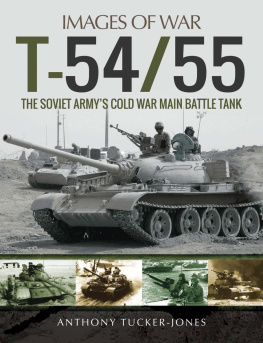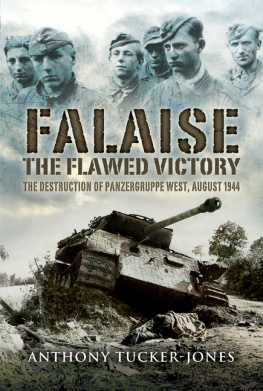Anthony Tucker-Jones - The Devils Bridge: The German Victory at Arnhem, 1944 (Osprey General Military)
Here you can read online Anthony Tucker-Jones - The Devils Bridge: The German Victory at Arnhem, 1944 (Osprey General Military) full text of the book (entire story) in english for free. Download pdf and epub, get meaning, cover and reviews about this ebook. year: 2020, publisher: Bloomsbury Publishing Plc, genre: History. Description of the work, (preface) as well as reviews are available. Best literature library LitArk.com created for fans of good reading and offers a wide selection of genres:
Romance novel
Science fiction
Adventure
Detective
Science
History
Home and family
Prose
Art
Politics
Computer
Non-fiction
Religion
Business
Children
Humor
Choose a favorite category and find really read worthwhile books. Enjoy immersion in the world of imagination, feel the emotions of the characters or learn something new for yourself, make an fascinating discovery.
- Book:The Devils Bridge: The German Victory at Arnhem, 1944 (Osprey General Military)
- Author:
- Publisher:Bloomsbury Publishing Plc
- Genre:
- Year:2020
- Rating:3 / 5
- Favourites:Add to favourites
- Your mark:
- 60
- 1
- 2
- 3
- 4
- 5
The Devils Bridge: The German Victory at Arnhem, 1944 (Osprey General Military): summary, description and annotation
We offer to read an annotation, description, summary or preface (depends on what the author of the book "The Devils Bridge: The German Victory at Arnhem, 1944 (Osprey General Military)" wrote himself). If you haven't found the necessary information about the book — write in the comments, we will try to find it.
Anthony Tucker-Jones: author's other books
Who wrote The Devils Bridge: The German Victory at Arnhem, 1944 (Osprey General Military)? Find out the surname, the name of the author of the book and a list of all author's works by series.
The Devils Bridge: The German Victory at Arnhem, 1944 (Osprey General Military) — read online for free the complete book (whole text) full work
Below is the text of the book, divided by pages. System saving the place of the last page read, allows you to conveniently read the book "The Devils Bridge: The German Victory at Arnhem, 1944 (Osprey General Military)" online for free, without having to search again every time where you left off. Put a bookmark, and you can go to the page where you finished reading at any time.
Font size:
Interval:
Bookmark:



Contents
Firstly, lastly and always to my wife Amelia, without whose unfailing support I would have given up long ago.
To Matt Lowing at Bloomsbury and Lisa Thomas formerly at Osprey for giving this book a home. Lisa in particular for fully embracing The Other Side of the Hill approach, which had not been attempted for some considerable time. Similarly, Ospreys publisher Marcus Cowper for his unstinting enthusiasm and guidance throughout.
To fellow author and military historian Professor Peter Caddick-Adams for his astute input and for very generously writing the excellent foreword. He sets the scene with such aplomb. Likewise, to Dr Graham Goodlad, Robin Buckland and Rob Palmer for reading the manuscript so diligently. Their expert comments, observations and support were gratefully received. Also to author and writer Tim Newark for his encouragement.
Those who kindly rallied to my call for help with research include Marcus Cowper, Katie Eaton, Barbara Jones, Tara Moran, Amy Rigg and Jol Stoppels.
To Tim Isaac who first sowed the seed. Tim, thanks for letting me sit in your Horsa glider. Even firmly on the ground, its a very sobering experience.
Lastly, and definitely not least, to my copy editor Venetia Bridges and proofreader Sharon Penlington. They are the unsung heroes in the process of pulling a book together ready for publication.
Thank you to everyone who helped.
Foreword
by Professor Peter Caddick-Adams
Watching the Allied airborne army circling, vulture-like, over the Dutch skies on the morning of Sunday, 17 September 1944, General Kurt Student the victor of Crete lamented that he never had such powerful means at my disposal! Wherever I looked I saw aircraft; troop-carriers and large aircraft towing gliders.
It is easy to forget that Operation Market Garden the Allied plan to force a 60-mile salient into German lines, outflanking the Siegfried Line (aka the Westwall) and enabling an invasion route into northern Germany took place so soon after the collapse in Normandy. With some 50,000 Axis troops killed or captured in the Falaise Pocket when it was sealed on 21 August, and the liberation of Paris four days later, it was obvious to all that the German armies of the West were defeated. Totally and irretrievably. Including those forces destroyed in the Riviera landings from 15 August onwards, German losses in France from 6 June tallied close to the half a million mark.
This was the origin of the plan with hindsight, absurdly optimistic to plunge into Holland by parachute and tank. The Germans were finished, and there was nothing left with which to oppose Montgomerys headlong rush, mounted a little over three weeks after Paris was formally freed. Yet the Germans were not finished; the Eastern Front had taught them how to stitch together shattered fronts with inadequate reserves. This was where Walther Model, now Army Group B commander in the West, had earned his reputation as a patchwork quilt artist of the first order.
Over the past couple of decades, dozens of books, scholarly papers, conferences and documentaries have taught us an enormous amount about the Allied airborne forces, aircrew and ground troops who invaded the Netherlands that September Sunday. Yet it is 30 years since the last study of the Germans who fought at Market Garden . In The Devils Bridge , Anthony Tucker-Jones using his skill as a defence analyst and a military historian gives us the German view of the nine-day Market Garden campaign, using a wide variety of sources, interviews and archives. Using many sets of eyes, we are taken effortlessly from tactical combat to operational narrative and back again. We are also given the vital back story from Normandy and Belgium into Holland, and the post-September aftermath overlooked in previous histories.
Using a cast of over a hundred individuals, he shows us how experienced and resourceful the defenders were. Labouring under the constraints of no air cover, limited resources and manpower, this long-overdue examination demonstrates how the ragtag collection of Wehrmacht, Luftwaffe and Waffen-SS units in Holland some summoned from far away and travelling by bicycle overcame all obstacles, combined into ad hoc battle groups and crushed their opponents, usually with no intelligence preparation, and little battlefield reconnaissance. Time and time again we encounter the legendary Nazi fanaticism. When SS-Major Josef Sepp Krafft advanced to fight the British at Oosterbeek, he sent his personal effects in his staff car home to Germany, observing, I dont expect to get out of this alive, but nevertheless pressed home his attack and survived.
We meet Erwin Kirchhof, a war correspondent, who explained the recipe for success. Only 24 hours before they had not known each other: the aeroplane technicians still worked on their planes; the soldiers of the Waffen-SS were refitting; the reserve units were still employed as guards; the naval coast artillery men had just returned; the boys of the Reich labour organization were still constructing field positions. Only a few of them were familiar with the principles of fighting but they fought
In total contrast, Tucker-Jones describes the truce arranged on 24 September between British medical officer Colonel Graeme Warrack and SS-Major Dr Egon Skalka, his opposite number from the 9th SS Division. The humane gesture saved the lives of 450 British, German and Dutch casualties, and was followed up by SS-General Wilhelm Bittrich presenting Warrack with a bottle of brandy, for your general. One of the few Allied eyewitnesses (for this is the German story) we meet is Captain Derek Pip Bogaerde, who witnessed the final British evacuation from Arnhem. We all knew him better as Dirk Bogarde, master of stage and screen.
The Devils Bridge provides a great service by examining at length what the Allies did and didnt know beforehand of the German dispositions, and logs the Wehrmachts reactions to the battle, with the lessons they identified and should have learned. However, in the aftermath of this strange victory the last the Germans would achieve in the West Hitler was possessed of exactly the same overconfidence that had gripped Montgomery after Normandy. In December he sent three armies through the Ardennes in a poor imitation of Market Garden . Wacht am Rhein s aim was to carve a 120-mile Panzer corridor from the Westwall to Antwerp.
The Fhrer had overlooked the fact that if Montgomery couldnt manage 60 miles in September with air cover and in good weather, the Germans certainly werent going to achieve double that in atrocious conditions with no air support. In this way, the successful defeat of Market Garden helped sow the seeds of the disastrous Ardennes offensive and final military collapse of Germany in the West.
This is an important and timely operational analysis of the events of September 1944. It is a mark of my respect for Anthony Tucker-Jones work that I wish I had researched and written The Devils Bridge . Thus I am more than happy to commend his scholarship to you.
Professor Peter Caddick-Adams
Salisbury
Prologue
Model Gets Indigestion
Field Marshal Walther Model was a prompt man. He was also a very calm man. A veteran of the highs and lows of the Eastern Front, he was by and large completely unflappable. He had seen it all, including the catastrophic German collapse in Russia. Model looked at his watch; it was one oclock on Sunday 17 September 1944. He then nodded to his chief of staff Lieutenant-General Hans Krebs, adjutant Colonel Leodegard Freyberg and operations officer Colonel Hans Georg von Tempelhoff. Model rubbed his hands together with anticipation; it was time for a nice pre-lunch aperitif, a chilled Moselle.
Font size:
Interval:
Bookmark:
Similar books «The Devils Bridge: The German Victory at Arnhem, 1944 (Osprey General Military)»
Look at similar books to The Devils Bridge: The German Victory at Arnhem, 1944 (Osprey General Military). We have selected literature similar in name and meaning in the hope of providing readers with more options to find new, interesting, not yet read works.
Discussion, reviews of the book The Devils Bridge: The German Victory at Arnhem, 1944 (Osprey General Military) and just readers' own opinions. Leave your comments, write what you think about the work, its meaning or the main characters. Specify what exactly you liked and what you didn't like, and why you think so.

